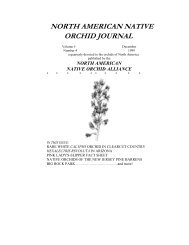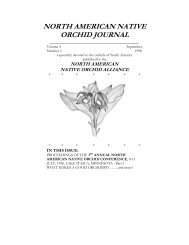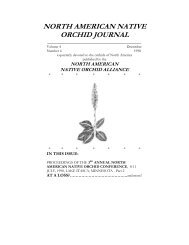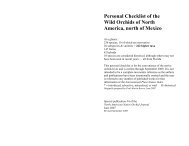north american native orchid journal - at The Culture Sheet
north american native orchid journal - at The Culture Sheet
north american native orchid journal - at The Culture Sheet
You also want an ePaper? Increase the reach of your titles
YUMPU automatically turns print PDFs into web optimized ePapers that Google loves.
Pelch<strong>at</strong>: SPIRANTHES PARKSII CORRELL – NAVASOTA LADIES’-TRESSES<br />
hairs can be observed in the thro<strong>at</strong> of the corolla formed by the<br />
lip, dorsal sepal and petals, (Figure 3). <strong>The</strong> distinctive oval shape<br />
of the petals (Correll 1947) can be seen, in the field, under close<br />
observ<strong>at</strong>ion with a loupe or through the lens of a camera. <strong>The</strong><br />
floral bract is white tipped which is often referred to as a single<br />
identifying characteristic of this <strong>orchid</strong>, but (in this authors<br />
experience) cannot in itself be used as a single characteristic for<br />
identific<strong>at</strong>ion because S. cernua can also show a tendency for<br />
whitening of the floral bracts. Overall the flower shape is quite<br />
distinctive in th<strong>at</strong> it appears to be short and f<strong>at</strong>. When viewed<br />
from the side, the flower from the ovary to the tip of the dorsal<br />
sepal forms an arch giving the flower a humped shape in rel<strong>at</strong>ion<br />
to its length and width and extends horizontally from the rachis<br />
instead of drooping or nodding as in the case of S. cernua. <strong>The</strong><br />
dorsal sepal extends just beyond the petals, curls upward <strong>at</strong> the<br />
apex, and has a cleft <strong>at</strong> the apex. <strong>The</strong> l<strong>at</strong>eral sepals hug the corolla<br />
tightly and look like 2 upturned horns following the lines of the<br />
upturned apex of the dorsal sepal and extending a little beyond it.<br />
<strong>The</strong> flower coloring is white with vari<strong>at</strong>ions from creamy yellow<br />
to white in the center of the lip and yellow to light green coloring<br />
running through the petals from the base to the midpoint.<br />
In the same loc<strong>at</strong>ion and blooming simultaneously, as<br />
mentioned above, with Spiranthes parksii is S. cernua, (Fig. 4).<br />
<strong>The</strong>se plants include examples of the sexual and asexual apomictic<br />
types, along with peloric forms as well as the “cleistapogamic”<br />
characteristic referred to by C. Sheviak, (Sheviak, 1982) (Fig. 5). I<br />
have also observed examples of S. parksii th<strong>at</strong> appear to be<br />
apomictic, and exhibit some peloria, (Fig. 6). <strong>The</strong>se plants have<br />
monstrous looking flowers th<strong>at</strong> are tightly closed with the lip<br />
barely protruding pointing straight up parallel with the axis of the<br />
stem. On some of the flowers the l<strong>at</strong>eral sepals are <strong>at</strong> an angle<br />
away from the corolla and many of the unopened flowers below<br />
<strong>at</strong> the bottom of the spike are already withering while the ovaries<br />
are swelling. Another most unusual characteristic was the almost<br />
completely white floral bracts. Close examin<strong>at</strong>ion of these<br />
30













